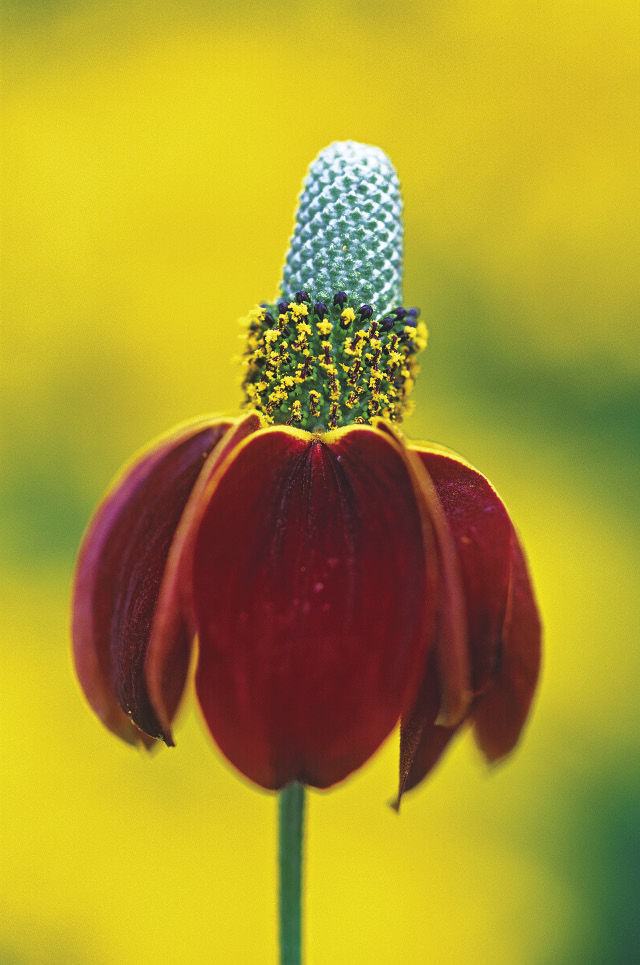
1. ‘Red Midget’ Mexican Hat

Name: Ratibida columnifera ‘Red Midget’
USDA Hardiness Zones: 3 to 8
Size: 18 to 36 inches tall and wide
Conditions: Full sun; dry to medium, well-drained soil
This compact selection of the prairie native is a playful, sun-loving showstopper for even the toughest conditions. Deep-red petals edged in gold surround a central cone that protrudes 1 to 2 inches above the petals, giving the plant its common name. Flowers appear in early summer through frost and seed readily. Many of the seeds will become feasts for songbirds, while others sow themselves into the soil for emergence the following spring. The showy flowers host an abundance of pollinators. Plants have an open, airy habit and finely cut foliage that is perfect for mixed borders.
2. ‘Iron Butterfly’ Ironweed

Name: Vernonia lettermannii ‘Iron Butterfly’
Zones: 4 to 9
Size: 3 feet tall and wide
Conditions: Full sun to partial shade; average to dry soil
‘Iron Butterfly’ ironweed is a late-summer to fall bloomer whose masses of bright purple flowers will revitalize the garden. The flowers also provide a nectar source for migrating monarchs, several species of fritillary and skippers, as well as eastern, tiger, and spicebush swallowtails. The fine, feathery foliage of ‘Iron Butterfly’ adds rich texture to the garden. The narrow leaves and airy, well-branched stems may look delicate, but this prairie native is a hardy plant indeed. ‘Iron Butterfly’ is heat and drought tolerant and also able to withstand brief periods of standing water, making it ideal for rain gardens.
3. Fringed Poppy Mallow

Name: Callirhoe digitata
Zones: 4 to 8
Size: 2 to 4 feet tall and 1 to 2 feet wide
Conditions: Full sun; tolerates a wide range of soils
Showy, long-blooming, and low-maintenance: Fringed poppy mallow offers the trifecta of garden perfection. The plant produces a profusion of bright magenta flowers atop long stalks from midspring to late summer. Slender, erect stems have a bluish tinge and bear fine, fingerlike foliage. Fringed poppy mallow, commonly found in the tallgrass prairies of the south-central plains, is a native alternative to tall verbena (Verbena bonariensis, Zones 7-10), and its airy bouquets gracefully complement high grasses. The plant grows easily from seed and establishes a long taproot, giving it excellent drought tolerance. Fringed poppy mallow is a favorite of bumblebees, making it a striking addition to a pollinator garden.
4. ‘Orange Peel’ Cestrum

Name: Cestrum ‘Orange Peel’
Zones: 7 to 10
Size: 3 to 6 feet tall and wide
Conditions: Full sun; average to dry, well-drained soil
Calling all hummingbirds: luxurious cestrum blooms for your sipping pleasure! With its abundance of cheery, yellow-orange blooms from spring until frost, this heat-loving, low-maintenance beauty is beloved by gardeners and birds alike. Soaring to heights of up to 6 feet, ‘Orange Peel’ cestrum provides structure to a design and acts as a willowy backdrop to midsize grasses. Flowers emit a sweet fragrance after the sun goes down. ‘Orange Peel’, among the most cold-hardy cestrums, is a deciduous shrub in Zones 8 to 10 and acts as a die-back perennial in Zone 7.
Kimberly Toscano is a horticulturist from Stillwater, Oklahoma.
Fine Gardening Recommended Products

Pruning Simplified: A Step-by-Step Guide to 50 Popular Trees and Shrubs
Fine Gardening receives a commission for items purchased through links on this site, including Amazon Associates and other affiliate advertising programs.

DeWalt Variable-Speed Cordless Reciprocating Saw
Fine Gardening receives a commission for items purchased through links on this site, including Amazon Associates and other affiliate advertising programs.

Planting in a Post-Wild World: Designing Plant Communities for Resilient Landscapes
Fine Gardening receives a commission for items purchased through links on this site, including Amazon Associates and other affiliate advertising programs.



















Comments
Log in or create an account to post a comment.
Sign up Log in